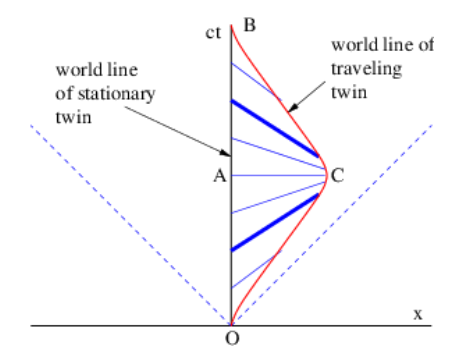4.6: Twin Paradox
- Page ID
- 32945
An interesting application of time dilation is the so-called twin paradox, which turns out not to be a paradox at all. Two twins are initially the same age. One twin travels to a distant star on an interstellar spaceship which moves at speed V , which is close to the speed of light. Upon reaching the star, the traveling twin immediately turns around and heads home. When reaching home, the traveling twin has aged less than the twin that stayed home. This is easily explained by the time dilation effect, which shows that the proper time elapsed along the world line of the traveling twin is \(\left(1-V^{2} / c^{2}\right)^{1 / 2}\) times the proper time elapsed along the world line of the other twin.
The “paradox” part of the twin paradox arises from making the symmetric argument in which one assumes the reference frame of the traveling twin to be stationary. The frame of the earth-bound twin must then travel in the sense opposite that of the erstwhile traveling twin, which means that the earth-bound twin must age less rather than more. This substitution is justified on the basis of the principle of relativity, which states that the laws of physics must be the same in all inertial reference frames.
However, the above argument is fallacious, because the reference frame of the traveling twin is not inertial throughout the entire trip, since at various points the spaceship has to accelerate and decelerate. Thus, the principle of relativity cannot be used to assert the equivalence of the traveler’s reference frame to the stationary frame.

Of particular importance is the period of deceleration and acceleration near the distant star. During this interval, the line of simultaneity of the traveling twin rotates, as illustrated in figure 4.9, such that the twin staying at home rapidly ages in the reference frame of the traveler. Thus, even though the acceleration of the traveling twin may occupy only a negligible segment of the twin’s world line, the overall effect is not negligible. In fact, the shorter and more intense the period of acceleration, the more rapidly the earth-bound twin ages in the traveling frame during this interval!


